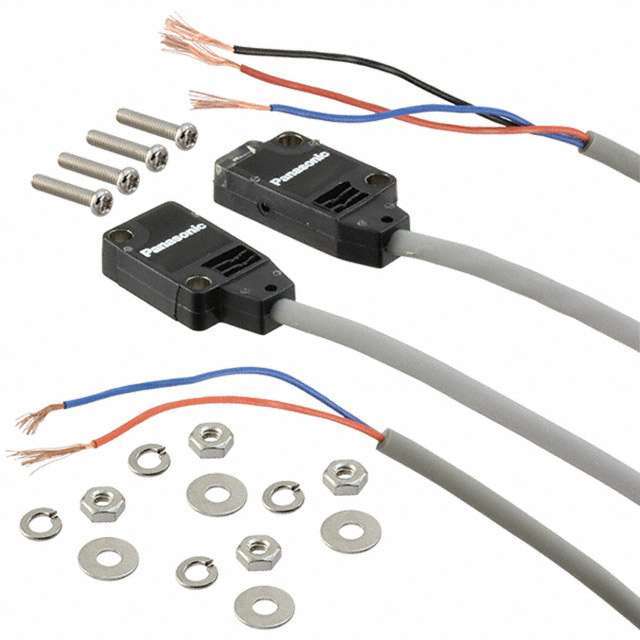Panasonic EX-11EB-PN Sensor: Features, Applications, and Buying Guide
What is the EX-11EB-PN Sensor?
The Panasonic EX-11EB-PN sensor is a compact photoelectric sensor used for object detection and motion sensing in production lines and automation systems. It is especially preferred for its easy installation in tight spaces and its cost-effective durability in industrial environments.
Features of the EX-11EB-PN Sensor
- Compact and Lightweight Design: Can be easily installed in limited spaces.
- Precise Detection: Works with millimeter-level accuracy, minimizing errors in production lines.
- Durable Structure: Built to withstand harsh industrial environments.
- Fast Response Time: Ideal for high-speed production lines.
- Multiple Detection Modes: Offers different detection modes for various needs (e.g., light interruption, reflection detection).
- Easy Integration: Quickly integrates into existing automation systems.
Applications of the EX-11EB-PN Sensor
- Production Lines: Used to detect whether objects are positioned correctly during production processes.
- Automation Systems: Provides precise motion control in robotic systems and is used for object recognition and direction control.
- Packaging Systems: Ensures packages are of the correct size and shape and helps segregate defective packages.
- Logistics and Warehouse Management: Tracks and directs products during transportation and ensures proper placement on shelves in warehouses.
- Food and Pharmaceutical Industries: Suitable for hygienic conditions, making it widely used in food processing and pharmaceutical production lines.
Advantages of the Panasonic EX-11EB-PN Sensor
- High Precision: Can accurately detect even the smallest objects.
- Low Power Consumption: Saves energy and reduces operating costs.
- Easy Installation: Simple installation process saves time.
- Cost-Effectiveness: Long-lasting design reduces operational costs.
- Versatility: Designed for use in a wide range of industries.
Buying Guide for the Panasonic EX-11EB-PN Sensor
1. Where to Buy?
The Panasonic EX-11EB-PN sensor can be purchased from authorized Panasonic dealers or trusted online stores. Reliable options include:
- Authorized Panasonic distributors.
- Online marketplaces (e.g., Amazon, eBay).
- Stores specializing in industrial automation equipment.
2. Price Comparison
The price of the EX-11EB-PN sensor may vary depending on the supplier. To find the best price for the EX-11EB-PN sensor, compare offers from different vendors.
3. Guarantee of Original Products
Ensure you buy an original Panasonic sensor by choosing reliable sellers. Counterfeit products may increase costs in the short term and cause system malfunctions.
Technical Data (Datasheet) for the EX-11EB-PN Sensor
| Feature | Value |
|---|---|
| Detection Distance | 5 mm – 20 mm |
| Response Time | 0.5 ms |
| Operating Voltage | 12-24V DC |
| Output Type | Transistor output (PNP/NPN) |
| Operating Temperature | -10°C to +55°C |
Maintenance Tips for the EX-11EB-PN Sensor
- Lens Cleaning: Regularly clean the lens to improve detection performance.
- Connection Check: Ensure cables are securely connected.
- Periodic Testing: Regularly test the sensor’s detection accuracy.
- Spare Parts Stock: Keep original spare parts on hand for potential malfunctions.
User Reviews for the EX-11EB-PN Sensor
Users of the EX-11EB-PN sensor have provided positive feedback, particularly on the following points:
- Easy Installation: Most users note that the sensor is simple and quick to install.
- Durability: Performs reliably even in challenging industrial conditions.
- Accurate Detection: Praised for its ability to detect even small objects precisely.
Some users have warned about counterfeit products and recommend purchasing from trusted sellers.
Conclusion
The Panasonic EX-11EB-PN sensor is a reliable solution for industrial automation and production processes. Its compact design, precise detection capabilities, and durability reduce error rates while increasing efficiency on production lines. Opt for a trusted supplier to purchase an original EX-11EB-PN sensor and benefit from its advanced features.
Related Articles: Learn more about the sensors by reading our blog on What is a Photoelectric Sensor?

